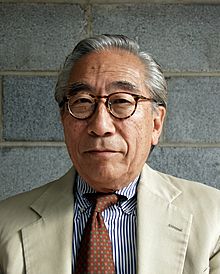Shoji Sadao facts for kids
Quick facts for kids
Shoji Sadao
|
|
|---|---|
 |
|
| Born | c.January 2, 19271 |
| Died | November 3, 2019 (aged 92) Tokyo, Japan
|
| Occupation | Architect |
| Spouse(s) |
Sawada Sadao
(m. 1972; died 2019) |
| Parent(s) | Riichi and Otatsu (Kodama) Sadao |
Shoji Sadao (born January 1927 – died November 3, 2019) was a Japanese American architect. He is most famous for working with two very important designers: R. Buckminster Fuller and Isamu Noguchi. Sadao was also a cartographer, which means he was an expert at making maps. He made maps for the U.S. Army during World War II.
Contents
Shoji Sadao's Early Life
Shoji Sadao was born in Los Angeles, California. During World War II, many Japanese Americans, including Sadao and his family, were sent to special camps. This happened because of a government order called Executive Order 9066. Sadao and his family were sent to the Gila River War Relocation Center in Arizona. In 1945, he joined the U.S. Army and served for four years.
Working with Buckminster Fuller
Sadao met Buckminster Fuller when he was studying architecture at Cornell University in the early 1950s. Fuller was his teacher.
Creating the Dymaxion Map
In 1954, Sadao used his map-making skills to draw the Dymaxion Airocean World Map by hand. This was his first project with Fuller. This special map shows the Earth's landmasses without much distortion, like they are all connected. The first version of this map was printed in 1954.
Designing Giant Domes and Cities
In 1964, Sadao and Fuller started their own architecture company called Fuller & Sadao Inc. Their first big project was to design a huge geodesic dome for the U.S. Pavilion at Expo 67 in Montreal, Canada. Geodesic domes are strong, lightweight structures shaped like parts of a sphere.
A few years later, in 1968, Fuller and Sadao designed something called Tetrahedron City. This was a huge floating city planned for a Japanese businessman named Matsutaro Shoriki.
- It was designed to hold one million people in 300,000 apartments.
- It included a large inner harbor.
- The city was meant to be an efficient and sustainable place to live.
- It was built using a special aluminum frame system, which made it strong and affordable.
- Because it floated on the sea, it didn't take up valuable land space.
Working with Isamu Noguchi
Sadao also worked closely with another famous artist and designer, Isamu Noguchi.
Sculptures and Fountains
In 1959, Sadao helped Noguchi create a folded aluminum sculpture. In the 1960s, Sadao began working with Noguchi on gardens and outdoor designs. In 1971, they formed a company to design the Philip A. Hart Plaza and the Horace E. Dodge and Son Memorial Fountain in Detroit. Sadao also helped Noguchi make his famous Akari Light Sculpture, which are beautiful paper lamps.
The Noguchi Museum
In 1981, Sadao and Noguchi started working on the Isamu Noguchi Garden Museum. This museum, now called the Noguchi Museum, is in Long Island City, New York. It shows many of Noguchi's amazing artworks.
Shoji Sadao was a very important partner to both Fuller and Noguchi. He often worked behind the scenes, which he described as being "self-effacing," meaning he didn't seek attention for himself.
Shoji Sadao's Later Years
From 1989 to 2003, Sadao was the Executive Director of the Noguchi Museum. He is now an honorary trustee there for life. He also wrote a book called Buckminster Fuller and Isamu Noguchi: Best of Friends. This book shares details about how Fuller, Noguchi, and Sadao worked together and influenced each other.
Shoji Sadao passed away in Tokyo, Japan, on November 3, 2019.

